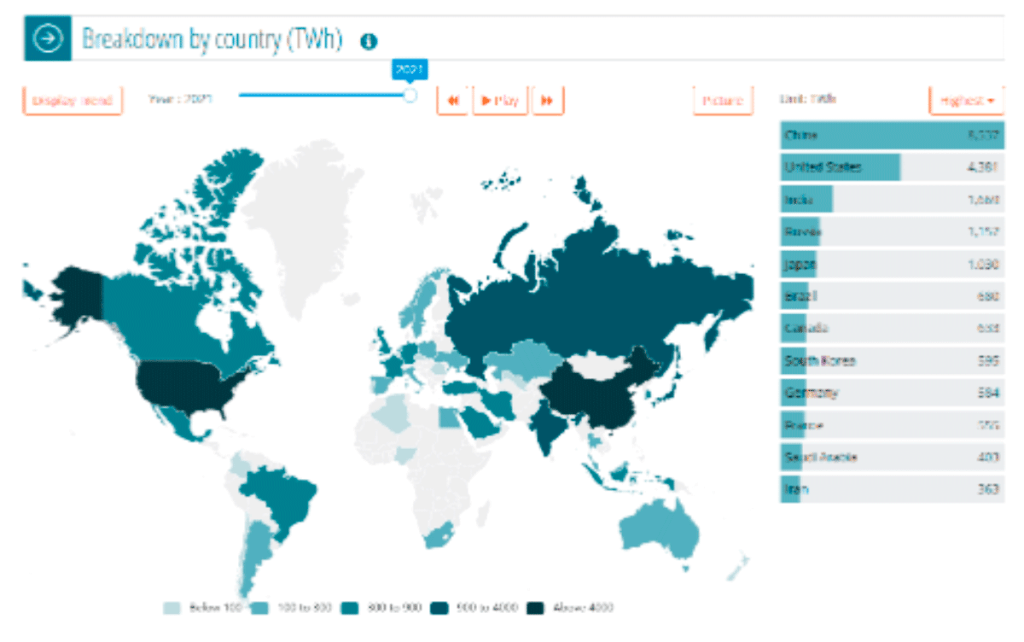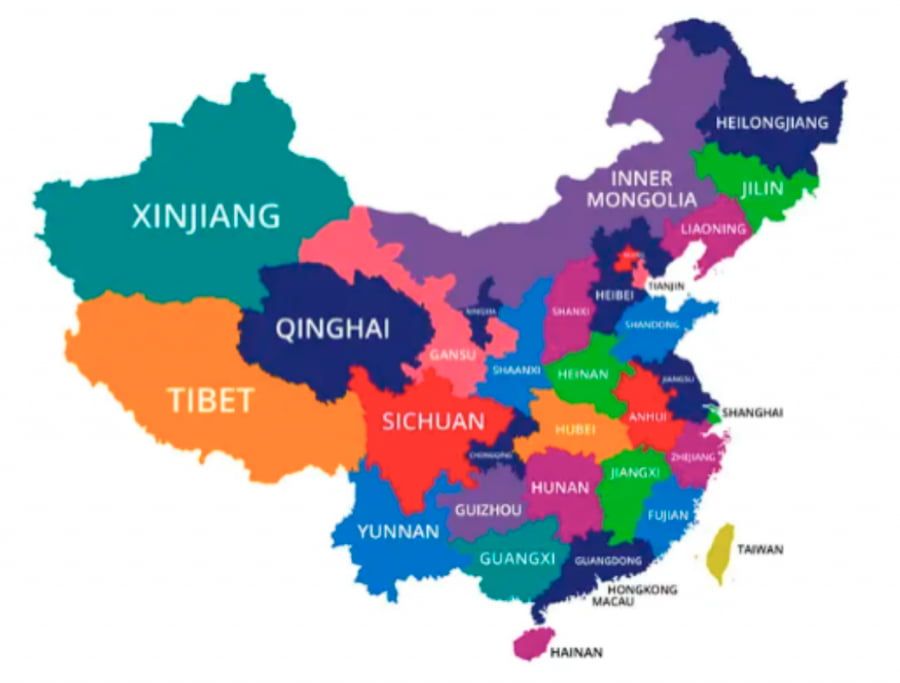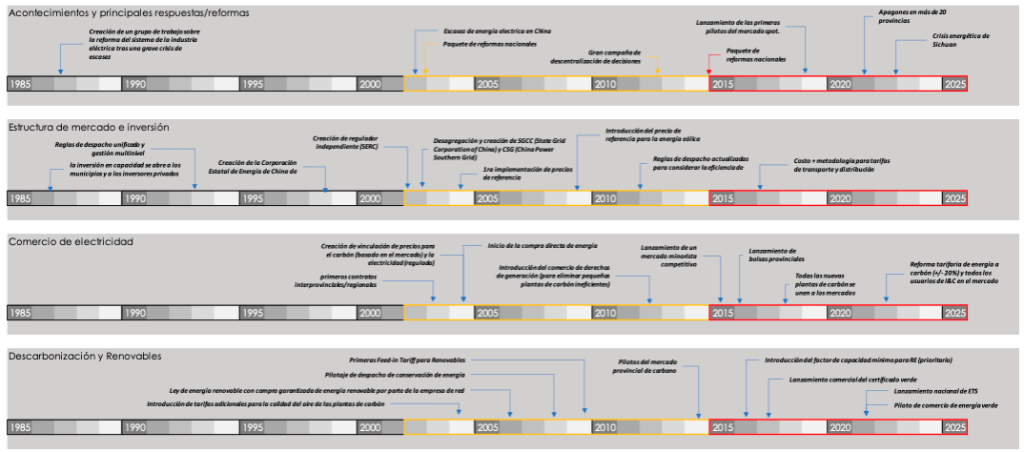
This small document aims to give a quick overview of the largest electricity market in the world, its challenges and needs in the coming years. The Chinese electricity system has an electricity production of 8 849 terawatt-hours (TWh) in 2022, surpassing the combined annual generation of the United States (4 524 TWh), the European Union (2 842 TWh) and Japan (1 017 TWh).


Fig.- Datos de Enerdata (World Energy & Climate Statistics)
Historically dominated by coal, it alone accounts for 14% of the global energy sector’s CO2 emissions and more than 40% of China’s energy-related CO2 emissions. Therefore, any change in the Chinese energy sector has significant repercussions globally. The transformation of the electricity sector is one of the foundations of the clean energy transition needed to achieve the goal of maximum carbon dioxide emissions by 2030 and carbon neutrality by 2060 (announced by President Xi Jinping in September 2020).
While administrative mechanisms (provinces) have been the main driver of the electricity sector in achieving energy and climate policy objectives in the past, continued competition among coal plants has improved the efficiency and environmental attributes of the electricity market. However, it was the last major round of reforms initiated in 2015 that gave a decisive boost to the markets to encourage flexibility as the electricity system is transformed.
Prior to the implementation of electricity market reforms, China had a largely centralized power sector, with the state-owned State Grid Corporation of China (SGCC) controlling the transmission and distribution of electricity across the country.

In recent years, China has undertaken reforms to introduce more market-oriented mechanisms in its electricity sector, including the establishment of provincial energy markets. These reforms aim to promote competition, improve efficiency and attract private investment in the electricity industry. Provincial energy markets allow the commercialization of electricity between generators, distributors and large consumers within a specific province. They provide a platform for market participants to buy and sell electricity based on supply and demand conditions as well as market prices.
Key features of China’s provincial energy markets include:
- Power generation: Generators, including state and private power plants, can sell their electricity production on the market. This allows for a more diverse mix of power generation sources, including coal, natural gas, renewables (such as wind and solar), and others.
- Power purchase: Distribution companies (often state-owned) and large consumers can buy electricity from the market to meet their demand. They can choose from a variety of available suppliers and negotiate prices based on market conditions.
- Market prices: Electricity prices in provincial energy markets are generally determined through market-based mechanisms. Prices may vary based on factors such as supply and demand, fuel costs, transmission restrictions, and other market conditions.
- Trading mechanisms: Provincial energy markets may employ different trading mechanisms, such as bilateral contracts, spot markets, futures contracts and energy exchanges. These mechanisms allow market participants to manage their electricity procurement and hedge against price fluctuations.
- Market regulation: Provincial energy markets are regulated by government authorities, such as the National Energy Administration (NEA) and local regulatory bodies. These entities oversee market operations, monitor compliance with market rules, and ensure fair competition.
It is important to note that the implementation and structure of provincial energy markets may vary between different provinces in China. Some provinces have made significant progress in establishing and operating their energy markets, while others are still in the early stages of market reform. Overall, China’s provincial energy markets are part of broader efforts to liberalize and modernize the country’s energy sector, promoting competition, efficiency, and integration of renewable energy sources.
Milestones of China’s Power Sector Reform

China’s electricity market reform in 2015 marked a significant milestone in the country’s effort to promote efficiency, competition and the integration of renewable energy sources into its electricity system. This reform was implemented with the aim of addressing the challenges associated with over-reliance on coal, improving air quality and fostering sustainable development.
- As in the process of market liberalization in Europe, one of the main measures taken in the reform was the separation of electricity generation and distribution functions. Before the reform, Chinese power companies were monopolistic and controlled both power generation and distribution. However, this reform promoted the creation of independent generation companies and the introduction of competition in the electricity market.
- He sought to establish a more market-based pricing system. Previously, electricity prices in China were regulated by the government, making competition and market efficiency difficult. With the reform, mechanisms were put in place to allow electricity prices to be determined more transparently and better reflect supply and demand.
- It also actively promoted the development and integration of renewable energy sources. Incentive policies, such as “feed in tariffs”, were introduced to encourage electricity generation from renewable sources, such as wind and solar power. In addition, requirements were implemented for grid operators to purchase a minimum amount of renewable energy, which helped drive its adoption and reduce reliance on coal.
- Another key measure of the reform was the creation of regional energy markets in China. Previously, most electricity transactions were conducted within provinces, limiting efficiency and making it difficult to integrate renewables nationwide. Regional energy markets allow for greater competition and facilitate the transfer of energy between regions, helping to balance supply and demand across the country.
Overall, China’s electricity market reform in 2015 laid the groundwork for a broader transformation of the country’s energy system. It has fostered the diversification of the energy matrix and promoted competition, efficiency and the integration of renewable energy sources. With the government’s continued momentum and growing commitment to sustainability, the Chinese electricity market is expected to continue to evolve and play a crucial role in the global transition to a low-carbon economy.
Despite the reforms, short-term markets have not reached their full potential despite the possibilities they bring to unlock flexibility. The 2015 reform included the deployment of spot energy markets (daily and intraday) to implement economic dispatch and unlock the flexibility of supply and demand resources. In market-based systems, these short-term markets play a central role in price formation and support the security of electricity. In China, the first provincial spot market pilots were launched in 2019, and some of them operate continuously now. Spot markets are expanding across the country, but their share of trade remains small and the connection with other established markets (MLT, complementary services) is in practice still being completed.
Medium to Long Term (MLT) markets are the most developed form of market in China. Launched under the 2015 reform, MLT contracts have gradually replaced the administrative allocation of hours to generators. Today, MLT contracts cover half of the electricity consumed and around four-fifths of the volume traded. While the most common contracts have a duration of one year to one month, shorter and longer contracts are appearing, which can now be negotiated directly between consumers and generators or on energy exchanges.
Better distribution of resources throughout the country requires national coordination of local markets. The uneven geographical distribution of resources and demand in China has led to national projects to transfer energy across the country. These interprovincial flows are supported by firm, one-way MLT contracts. The 2015 reform gave provinces autonomy to define markets at the provincial level. The resulting market designs, which can diverge significantly, in combination with local economic incentives favor interprovincial trade. Sharing resources cost-effectively will require mor
Conclusions
In recent years, the Chinese electricity market has become a global powerhouse, reflecting the country’s commitment to sustainable development and rapid economic growth. As the world’s most populous nation and largest energy consumer, China’s energy policies and market dynamics have far-reaching implications not only for its own citizens but also for global energy markets.
China’s commitment to renewables has been the driving force behind its revolution in the energy market. The country has become the world’s largest producer, consumer and investor in renewable energy. The Chinese government has implemented several policies to incentivize the deployment of renewable energy, tax exemptions and subsidies.
State Grid Corporation of China (SGCC) and China Southern Power Grid (CSG) are the two dominant state-owned enterprises that operate most of China’s power transmission and distribution infrastructure. These companies play a key role in ensuring the reliability and stability of the electricity grid. In addition, several power generation companies, both state-owned and private, actively participate in the Chinese electricity market.
While the Chinese electricity market has made impressive strides, it faces challenges and opportunities. A major challenge is the integration of intermittent renewable energy sources into the grid, which requires energy storage solutions and grid flexibility. In addition, the process of market liberalization needs to be further developed to foster competition and attract private investment. On the other hand, China’s electricity market presents immense opportunities for international collaboration and the development of advanced energy technologies.
If you found it interesting, please share it!
Recent Articles



































